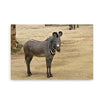The Oldest Photograph of the Moon: Taken by John William Draper in 1840
Introduction
The Moon, an object of human fascination for millennia, has been observed and depicted in many ways throughout history. However, it was in 1840 that a revolutionary breakthrough occurred with the first photograph of the Moon, taken by John William Draper , an American scientist and pioneer of photography. This image, although blurry by today's standards, marked a historic moment in astronomical observation and scientific photography.
Who was John William Draper?
John William Draper (1811–1882) was an English-born American scientist, chemist, physician, and astronomer. He is known for his many contributions to photography, chemistry, and medicine. Draper was particularly interested in new developments in photography, and he was one of the first to apply this emerging technology to astronomy.
Draper and Photography
Draper, inspired by recent discoveries in the daguerreotype, set out to improve the process in order to capture astronomical images. After some experimentation, he became the first person to successfully photograph the Moon in a recognizable way. This success earned him recognition as one of the pioneers of astronomical photography .
The First Photograph of the Moon
1. The Technical Context
In 1840, photography was still in its infancy, with Louis Daguerre 's daguerreotype at the forefront of technology. This technique involved exposing a silver-coated copper plate that had been sensitized to light. The long exposure times required to capture an image, combined with the technical challenges of capturing celestial objects, made the task extremely complex.
2. The Daguerreotype of the Moon
John William Draper's photograph of the Moon in March 1840 was taken from the New York University Observatory. Using a telescope and a daguerreotype camera, Draper managed to capture an image of the Moon on a metal plate, marking the first successful photograph of a celestial object other than Earth. This image depicted the Moon's disk with its distinct craters and shadows, although it is considered blurry compared to today's images.
3. A Revolutionary Exploitation
Although this first photograph seems modest, it opened new perspectives in scientific observation. Before this, astronomers had to draw or directly observe celestial objects. With photography, it became possible to capture images for further study, comparing and analyzing details that could not be faithfully reproduced by hand.
The Importance of Lunar Photography
1. A Breakthrough for Astronomy
Draper's photograph of the Moon allowed astronomers to begin capturing and studying the Moon and other celestial bodies in an entirely new way. This first image marked the beginning of astronomical photography , a discipline that would become essential to future discoveries in astronomy.
2. Scientific Photography
In addition to its applications in astronomy, Draper's photograph demonstrated the usefulness of scientific photography for capturing and analyzing phenomena that are difficult to observe in real time. The process has been applied to many other scientific disciplines, such as biology and chemistry, and remains an indispensable method for documenting and understanding complex phenomena today.
3. Inspiration for Future Generations
Draper's photography not only inspired astronomers and scientists of his time, but also paved the way for decades of space exploration, culminating in the first images of the Moon taken from space by Apollo astronauts.
The Evolution of Astronomical Photography
1. From Daguerreotype to Modern Devices
While Draper's 1840 photograph of the Moon was a remarkable first, technological advances quickly transformed the way astronomers captured images of the sky. With improvements in telescopic lenses and new photographic techniques, 19th-century astronomers began capturing sharper, more detailed images of the Moon, stars, and planets.
2. Contemporary Lunar Exploration
With the rise of space technology, lunar photography reached its peak in the 1960s when the Apollo 11 mission allowed astronauts to photograph the Moon from its surface. Today, images of the Moon are taken at extremely high resolutions using space telescopes, satellites, and rovers. But each new image reminds us of the significance of Draper's first successful attempt in 1840.
Conclusion
The first photograph of the Moon taken by John William Draper in 1840 is a milestone in the history of photography and astronomy. Draper, using the emerging techniques of daguerreotype, immortalized the lunar surface for the first time, paving the way for further exploration of the universe. Although crude by modern standards, this first image represents a revolutionary advance that changed our understanding of the cosmos.
If you want to capture the beauty of the universe or simply add an artistic touch to your decor, explore the photo posters available at The Poster Shop . You'll find inspiring images that recall the legacy of pioneers like Draper.
FAQs
Who took the first photograph of the Moon?
The first photograph of the Moon was taken by John William Draper in 1840, using the daguerreotype technique.
Why is this photograph important?
This photograph marks the first capture of a celestial object using light, paving the way for astronomical photography and scientific documentation of the sky.
What technique did John William Draper use to capture the Moon?
Draper used a daguerreotype and a telescope to capture an image of the Moon, requiring a long exposure time.
How has lunar photography evolved since Draper?
Since that first photograph, photographic and astronomical techniques have evolved considerably, allowing high-resolution images of the Moon and other celestial bodies using modern telescopes and space missions.




































































Leave a comment
All comments are moderated before being published.
This site is protected by hCaptcha and the hCaptcha Privacy Policy and Terms of Service apply.